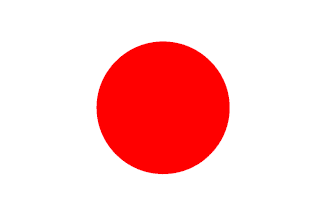 |
 |
PART 3 |
Friday 24 May 2013
With tram and train we travel to the suburban station of Mukainada. This
is the location of the main Mazda car factory. We pay a
visit to the
 Mazda
museum. We have signed up on line for the English tour at 10am. We are led
into a showroom with Mazda’s latest models, that are made here in Hiroshima.
A bus takes us to the museum some 5km further down on the factory grounds.
Mazda’s plant here is gigantic in size (7x3 km) with its own power plan and
port. In the museum we are first introduced to a number of historic models
from the first Mazda on, a three wheel motorcycle made in 1931. This is
followed by a video presentation on the company’s history. Apparently Mazda
has been a pioneer in the application of the Wankel motor and recently the
hydrogen wankel engine. This an engine without cylinders, but with a
triangular rotor. It was developed by the German engineer Felix Wankel in
1954 for the already defunct car brand NSU. The Wankel engine is quieter and
with less moving parts also lighter. Disadvantage is its high fuel and oil
consumption. This is why Mazda no longer produces any cars with this type of
engine. They keep on developing it further, though. After the movie we are
led into the hall with the assembly line. We are not allowed to take
pictures in there. We see that a lot of work is done manually by car
workers. Robots do only the repetitive precision work like fitting the
windows. 5 models are being assembled her on the same line so that the
workers have some variation in there working day. Workers are also rotated
every three months between different stations on the line. After the
assembly line we get on the bus again, back to the main building. Mazda
produces around 5,000 cars a day here. There are 11 other production plants
in 9 countries. A car is produced in 15 hours. The cars take 35 days to get
to Europe.
Mazda
museum. We have signed up on line for the English tour at 10am. We are led
into a showroom with Mazda’s latest models, that are made here in Hiroshima.
A bus takes us to the museum some 5km further down on the factory grounds.
Mazda’s plant here is gigantic in size (7x3 km) with its own power plan and
port. In the museum we are first introduced to a number of historic models
from the first Mazda on, a three wheel motorcycle made in 1931. This is
followed by a video presentation on the company’s history. Apparently Mazda
has been a pioneer in the application of the Wankel motor and recently the
hydrogen wankel engine. This an engine without cylinders, but with a
triangular rotor. It was developed by the German engineer Felix Wankel in
1954 for the already defunct car brand NSU. The Wankel engine is quieter and
with less moving parts also lighter. Disadvantage is its high fuel and oil
consumption. This is why Mazda no longer produces any cars with this type of
engine. They keep on developing it further, though. After the movie we are
led into the hall with the assembly line. We are not allowed to take
pictures in there. We see that a lot of work is done manually by car
workers. Robots do only the repetitive precision work like fitting the
windows. 5 models are being assembled her on the same line so that the
workers have some variation in there working day. Workers are also rotated
every three months between different stations on the line. After the
assembly line we get on the bus again, back to the main building. Mazda
produces around 5,000 cars a day here. There are 11 other production plants
in 9 countries. A car is produced in 15 hours. The cars take 35 days to get
to Europe.
We go back into town and have lunch near our hotel. In the afternoon we have look inside B+B an electronics store. We are not particularly surprised by what’s on offer. Most of it is available back home. Apart from (expensive) flat screen TV’s we see lots of airco’s, rice cookers (more sophisticated than those at home), massage chairs and of course the Japanese toilet seats.
In
 Japan
the toilet seat is an electric appliance. The seat is heated and the
heat is controlled by a thermostat. It has a nozzle, which extends under
you, after you have pressed the button and sprays a water jet at body
temperature at 38 degree angle against your behind to rinse it clean.
The jet can also pulsate for that nice massage effect. Most seats also
have a nozzle at the front for the ladies. An extra feature is a
loudspeaker that produces flush sounds when you are seated. Japanese
find it very embarrassing if the sounds they produce while using the
toilet can be heard by others. To mask that, they flush frequently
during their visit to the toilet. That costs enor
Japan
the toilet seat is an electric appliance. The seat is heated and the
heat is controlled by a thermostat. It has a nozzle, which extends under
you, after you have pressed the button and sprays a water jet at body
temperature at 38 degree angle against your behind to rinse it clean.
The jet can also pulsate for that nice massage effect. Most seats also
have a nozzle at the front for the ladies. An extra feature is a
loudspeaker that produces flush sounds when you are seated. Japanese
find it very embarrassing if the sounds they produce while using the
toilet can be heard by others. To mask that, they flush frequently
during their visit to the toilet. That costs enor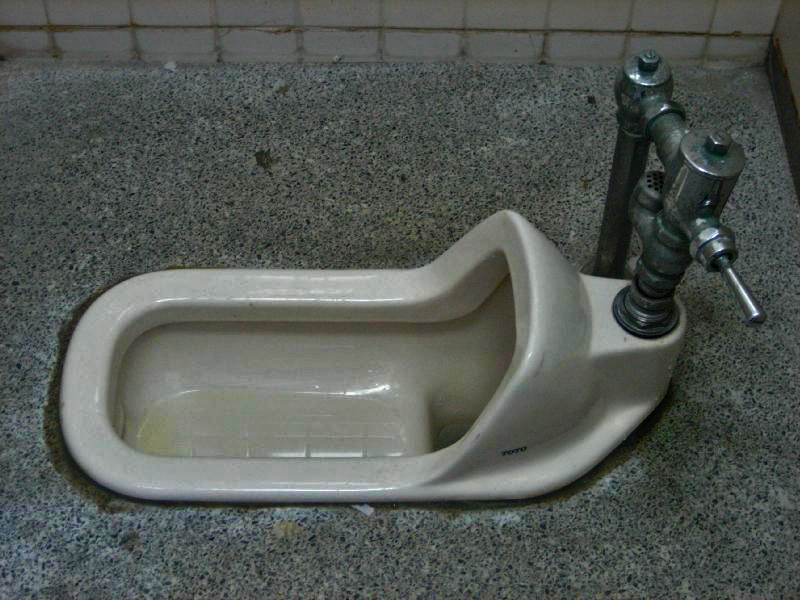 mous
quantities of water and this feature prevents that. Sometimes a blue
light shines within the bowl, illuminating the smallest room in the
house in blue lime light. The most luxurious models feature a movement
sensor, which initiates the lid to open when you enter the toilet which
means that you do not have to touch anything with your hands. The next
level will be that the toilet will make a urine analysis and send the
results via internet to your family doctor.
mous
quantities of water and this feature prevents that. Sometimes a blue
light shines within the bowl, illuminating the smallest room in the
house in blue lime light. The most luxurious models feature a movement
sensor, which initiates the lid to open when you enter the toilet which
means that you do not have to touch anything with your hands. The next
level will be that the toilet will make a urine analysis and send the
results via internet to your family doctor. Only very rarely you will still encounter a traditional Japanese squat toilet. For those familiar with the French squat toilet, this piece of s
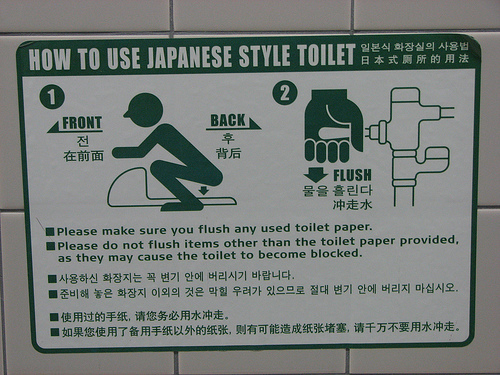 anitary
heritage may cause some confusion about how to use it. And Japan would
not be Japan if there would not be clear instructions for the ignorant
foreigner or postmodern Japanese.
anitary
heritage may cause some confusion about how to use it. And Japan would
not be Japan if there would not be clear instructions for the ignorant
foreigner or postmodern Japanese. In Japanese homes and in traditional hotels there will always be a pair of toilet slippers ready for you behind the door. You slip out of your house slippers before entering the toilet and you change into the toilet slippers. Upon leaving toilet you leave the toilet slippers behind, but do mind to leave them facing the visitor, so that he or she can slip into them without any trouble.
At night we eat at the shopping arcade behind Fukuya Dept store
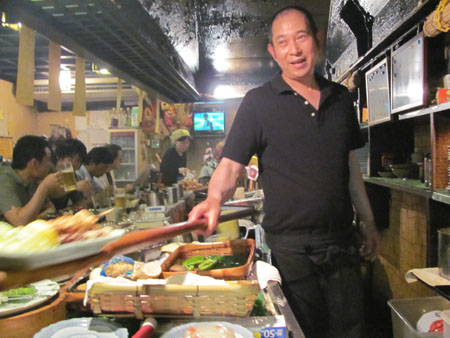 in
a cellar restaurant. It belongs to a Briton, who chats us into entering.
Inside we step into a different world. We are seated around a barbecue with
exclusively Japanese guests. The room is thick with smoke. A hyper active
woman takes our orders. When the food is ready your meal is handed to you by
the chef by means of some sort of spade with a very long stick. Quite an
experience and cheap too.
in
a cellar restaurant. It belongs to a Briton, who chats us into entering.
Inside we step into a different world. We are seated around a barbecue with
exclusively Japanese guests. The room is thick with smoke. A hyper active
woman takes our orders. When the food is ready your meal is handed to you by
the chef by means of some sort of spade with a very long stick. Quite an
experience and cheap too.
Weather: sunny and warm, 27°C/81°F.
Saturday 25 May 2013
Hiroshima - Kobe: 304km (190mi), 1:18 hours (train)
The Shinkansen train departs (on time of course) at 9.50 am to
Shin-Kobe. We arrive at 11.08 hours. Our
hotel, the
ANA Crowne Plaza
is situated opposite the station. We enter a world of luxury. Our room was
not ready, but if we pay an extra 4000 yen
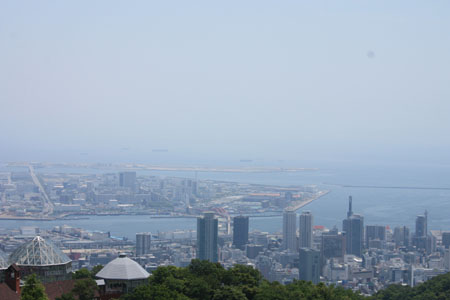 (€
30) we can immediately move into a larger room. So we do that. On the 18th
floor we have a very spacious room with a large bathroom en suite. The view
over the city is magnificent. We take the ropeway (cable car) up the
mountain to the Nunobuki herbal garden on the slopes of the
mount Rocco. From up there - and also on the way up - we have a breathtaking
view of the city. We look around and eat a simple but relatively pricey
lunch. Up on the mountain there are many day trippers. Herb plants and rose
cuttings are for sale in the shop. After enjoying the view in the blazing
sun we go down again with the cable car. Once at ground level we take the
regional train to the
Disaster Reduction and Human
Renovation Institution. From the train station on the
Hanshin Iwaya-line is a 15-minute walk to this particular institute, which
is dedicated to the great Kobe earthquake on January 17, 1995. This
earthquake, which is also known as the Great Hanshin Earthquake had a
magnitude of 7.3 on the Richter scale. The epicenter was 20km away from
Kobe. The quake lasted no more than 15 seconds, but it took 6,400 lives. The
damage amounted to more than 100 billion euros, 2.5% of Japan's
(€
30) we can immediately move into a larger room. So we do that. On the 18th
floor we have a very spacious room with a large bathroom en suite. The view
over the city is magnificent. We take the ropeway (cable car) up the
mountain to the Nunobuki herbal garden on the slopes of the
mount Rocco. From up there - and also on the way up - we have a breathtaking
view of the city. We look around and eat a simple but relatively pricey
lunch. Up on the mountain there are many day trippers. Herb plants and rose
cuttings are for sale in the shop. After enjoying the view in the blazing
sun we go down again with the cable car. Once at ground level we take the
regional train to the
Disaster Reduction and Human
Renovation Institution. From the train station on the
Hanshin Iwaya-line is a 15-minute walk to this particular institute, which
is dedicated to the great Kobe earthquake on January 17, 1995. This
earthquake, which is also known as the Great Hanshin Earthquake had a
magnitude of 7.3 on the Richter scale. The epicenter was 20km away from
Kobe. The quake lasted no more than 15 seconds, but it took 6,400 lives. The
damage amounted to more than 100 billion euros, 2.5% of Japan's
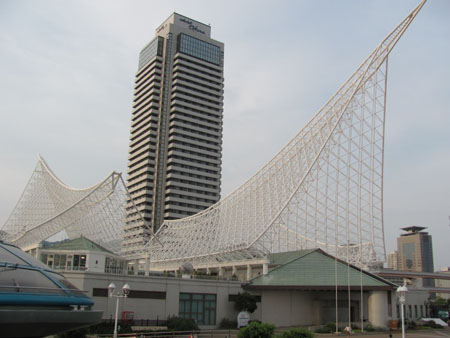 gross
domestic product at that time. The exhibition starts on the 4th floor with a
7-minute film that gives an impression of the natural disaster and its
effects on the city. Our jaws drop in shock. This show is followed by a
movie about the consequences of the disaster. From the perspective of a 15
year old girl we hear the story of the disaster, rescue work and
reconstruction. We are struck by he resilience of the Japanese society. The
rescue effort starts very quickly. Nearly a million volunteers bring aid
from all over Japan. After the rescue and emergency relief attention is
shifted to clearing the rubble, setting up emergency housing and
reconstruction. Much attention is being paid to the social aspects. A team
of social workers visit the victims for years after the disaster to assist
them in picking up their lives. In the reconstruction, the people are
closely involved. In any case, this results in better buildings and the
wider streets. After this film we come to a floor where the story continues
supported by figures and images. Volunteers, older men, who speak English
take us under their wing and lead us through the exhibition and tell us
their experiences and more facts. Striking is the speed with which the city
go
gross
domestic product at that time. The exhibition starts on the 4th floor with a
7-minute film that gives an impression of the natural disaster and its
effects on the city. Our jaws drop in shock. This show is followed by a
movie about the consequences of the disaster. From the perspective of a 15
year old girl we hear the story of the disaster, rescue work and
reconstruction. We are struck by he resilience of the Japanese society. The
rescue effort starts very quickly. Nearly a million volunteers bring aid
from all over Japan. After the rescue and emergency relief attention is
shifted to clearing the rubble, setting up emergency housing and
reconstruction. Much attention is being paid to the social aspects. A team
of social workers visit the victims for years after the disaster to assist
them in picking up their lives. In the reconstruction, the people are
closely involved. In any case, this results in better buildings and the
wider streets. After this film we come to a floor where the story continues
supported by figures and images. Volunteers, older men, who speak English
take us under their wing and lead us through the exhibition and tell us
their experiences and more facts. Striking is the speed with which the city
go t
back on its feet again. Within three months the train was running again and
after a year the Shinkansen was back in Kobe! The last evacuees could leave
their temporary accommodation after 5 years. Another floor down we get more
geological information. About the force of the earthquake relative to other
earthquakes, such as those in Szechuan or the latest one in Fukushima
(2011). The latter was much stronger, but also further away under the ocean
floor. Also, the phenomenon of ground water being forced up to the surface
by the earthquake is being demonstrated. The last volunteer who helps us
even speaks Dutch, because he has lived in Antwerp for some time
t
back on its feet again. Within three months the train was running again and
after a year the Shinkansen was back in Kobe! The last evacuees could leave
their temporary accommodation after 5 years. Another floor down we get more
geological information. About the force of the earthquake relative to other
earthquakes, such as those in Szechuan or the latest one in Fukushima
(2011). The latter was much stronger, but also further away under the ocean
floor. Also, the phenomenon of ground water being forced up to the surface
by the earthquake is being demonstrated. The last volunteer who helps us
even speaks Dutch, because he has lived in Antwerp for some time
In the evening we take the subway to the Meriken park at the port. The maritime museum is architecturally interesting, as is the Meridien hotel, which looks like a cruise ship. We then take the subway to Sanomiya, the central railway station in Kobe. This is also the entertainment center of the city. It is a short walk to the teppanyaki restaurant Misono. It sits on the 6th and 7th floor of a building with more restaurants. The restaurant prides itself to have been inventor of teppanyaki style cooking in 1945. Whether that is true or not we do not know, but the atmosphere is great. We sit at a round table around the hot plate with city views behind the chef. The cook is understated and friendly and even knows where Rotterdam is and that it is a major port - just like Kobe. We order Kobe beef and a salad and fried vegetables. Kobe Beef is a specialty. The beef has a structure that resembles marble because of the thin strings of fat that run through it. It is also very costly. It is all wonderfully well prepared. The beef is very tender and the garlic that goes with it is delicious. Finally we get some bean sprouts with crispy beef. An experience! We have coffee at Starbucks opposite the restaurant and are then off to the hotel. In the bar on the 36th floor we have a cocktail with a magnificent view of the city.
Weather: sunny and warm 27°C/81°F.
Sunday 26 May 2013
Kobe - Kanazawa: 300km (186 mi), 2:52 hrs (train)
Today we have the most extensive breakfast on our trip. The breakfast
buffet is unprecedented in choice of food and drinks. The staff is running
back to front to stock up everything and it tastes delicious. Even a bread
toaster,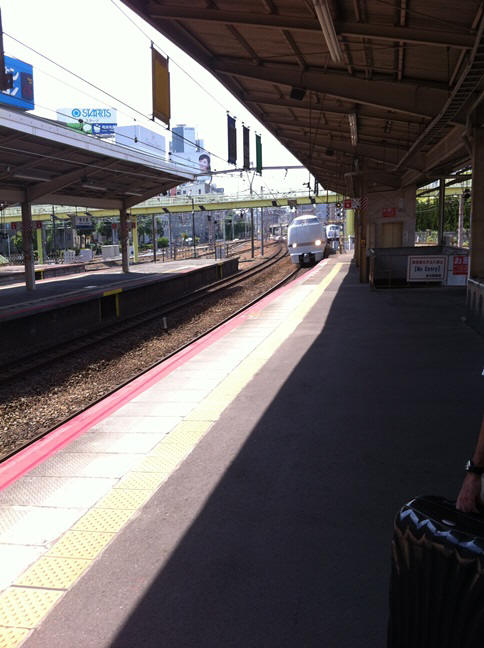 very unusual in Japan. After breakfast we want to drink coffee, but oddly
enough that is not possible in the hotel, at least not at 8.30am. We check
out and walk to the station. No problem getting coffee there. We also buy a
bento box, a lunch box. Ours contains tasty sushi.
very unusual in Japan. After breakfast we want to drink coffee, but oddly
enough that is not possible in the hotel, at least not at 8.30am. We check
out and walk to the station. No problem getting coffee there. We also buy a
bento box, a lunch box. Ours contains tasty sushi.
We take the Shinkansen Hikari ("Light") to Shin-Osaka. Because our reservation left us not much time to make our connection, we take a train earlier, on a unreserved seat. There are always at least three cars with unreserved seats on a Shinkansen train. In Osaka we change to the Thunderbird Limited express to Kanazawa. That is something like an express train. It is a long journey – in total, almost 3 hours. We come through Kyoto and ride for a long time along the lake East of Kyoto, which is, on a Sunday, full of people having fun: anglers, water skiers, jet skis etc. We arrive around 1pm in Kanazawa and take a taxi to a Ryokan, a traditional Japanese inn. Our original booking at Yamamuro was cancelled because of a death in the family. The alternative booked by them at Nakayasu across the street is very disappointing. It is jaded and the old owner is not very friendly, unlike his wife and children. It is also a very warm place to stay. There is a group of young athletes in the ryokan, but they behave exemplary. We decide not to stay three nights - as the plan was - but only one night and book a room in a nearby hotel online. We go there to take a look to see if we could check in early the next day. It is possible, but only after intervention of a charming English speaking waiter from the hotel restaurant. Then we relax a bit in the park near the Kanazawa castle. We drink coffee at Starbucks, do some shopping and have dinner at a small food stall near the market. When we come back to our room, our futon beds are made on the floor and a yakata (night robe) laid out. We go to the communal bath, where we are joined by three guys of the sport team. They shower and chat with each other endlessly. That's how they do it here, apparently. After our shower we dip in the hot tub. There we sit for a while until the water gets too hot for us. It makes you feel relaxed though.
Weather: very warm and sunny 29°C/84°F.
Monday 27 May 2013
We are the only guests who get the western style breakfast in the morning
and it is not bad at all: cereals, fried egg with bacon, bread with jam, tea
or coffee. The daughter of the house, who speaks excellent Englis,
spontaneously offers to call us a taxi. A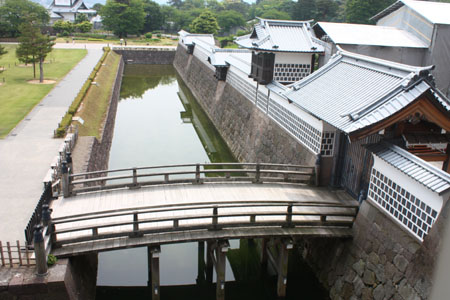 fter
brushing our teeth and packing our suitcases we are ready for the taxi to
our new stay, the
Kenrokusou
hotel.
fter
brushing our teeth and packing our suitcases we are ready for the taxi to
our new stay, the
Kenrokusou
hotel.
We drop off our suitcases at the hotel and go to Kanazawa Castle. It is a large complex that has burned down many times, due to acts of war and lightning. The last time in 1881. In 2001 the reconstruction was started, costing more than 5 billion yen. The reconstruction is still going on. It is a beautiful complex. In the courtyard a modern Japanese garden has been laid out. For reconstruction of the building, the original drawings used and the old building techniques were used. Inside the castle there is not much to see. The rooms are, except for a few panels with information, rather empty. The castle belonged to the Maeda family, until it was taken away from from them during Meiji Restoration. The Maeda were one of the top three noble families of the Edo era.
After having seen the castle extensively we go to the Omaya Jinja
shrine. The most beautiful Shinto shrine in Kanazawa. It is located
in a park. A group of older ladies in the temple park is busy with Japanese
flower arrangements, Ikebana. In the shrine a ceremony is in progress. What
kind, we do not know. The gate of the shrine is also special, because in the
turret above, are stained-glass windows that were made in late 19th century
by Dutch engineers. We take a long walk to a gold leaf workshop. Kanazawa is
known for its gold leaf work. 90% of the gold leaf in Japan comes from here.
We find the studio and shop called Katani and buy some souvenirs. We take a
taxi back to the hotel. 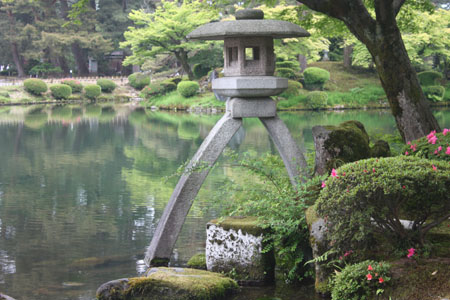 The
driver speaks fairly good English and says that he remembers the great Anton
Geesink, the first non-Japanese to win an Olympic gold medal in Judo in the
free category at the games in Tokyo in 1964.
The
driver speaks fairly good English and says that he remembers the great Anton
Geesink, the first non-Japanese to win an Olympic gold medal in Judo in the
free category at the games in Tokyo in 1964.
At 2.30pm we are picked up at the hotel by Kiyoe Nagashimo, a volunteer
guide of the
Kanazawa Goodwill Guide Network. Following a request from us via
the website of the Network, we have been linked to her. She takes us to the
Kenrokuengarden, which originally belonged to the castle
and was the private property the Maeda family. The family still exists and
lives in Tokyo, where all the noble families had to move during the Meiji
Restoration in the 19th century. Since then, the garden is open to the
public. The garden is known in Japan as one of the top three garden designs
of the country. We start with the Kotojitoro lantern. An icon for the
Japanese. There is a live TV camera focused on it 24/7. Every news broadcast
starts with live images of this lantern. In
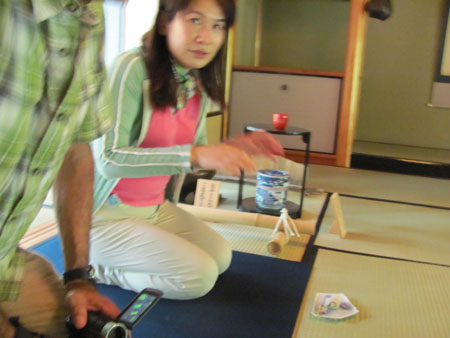 the
garden the six values of beauty are brought together, which on the face of
it cannot go together: space and shelter, artificial and authentic, water
and panoramic views. Everything has been thought out and everything is so
well maintained. The irises are in bloom. We see many pine trees
(symbolizing longevity), cherry trees and a few teahouses. In one of the
teahouses, Shiguretei, we attend a Japanese tea ceremony. The tea house
dating from 1725 has survived the great fire of 1759. Sitting on a tatami a
kimono-clad lady puts a bowl of tea in front of us. Kiyoe demonstrates for
us how we should do it. With great attention to detail and respect for the
person who has prepared the tea we drink the tea. The last sip has to be
taken with a slurping sound. This garden tea house has only sliding panels
with paper windows. In winter it is very cold. We walk through the garden
again and now exit in the directon of the Nagamachi Samurai district. In the
neighborhoods around the castle the members of the samurai class of soldiers
lived. These districts were and are a maze of streets. This is intentional
to make more difficult to
the
garden the six values of beauty are brought together, which on the face of
it cannot go together: space and shelter, artificial and authentic, water
and panoramic views. Everything has been thought out and everything is so
well maintained. The irises are in bloom. We see many pine trees
(symbolizing longevity), cherry trees and a few teahouses. In one of the
teahouses, Shiguretei, we attend a Japanese tea ceremony. The tea house
dating from 1725 has survived the great fire of 1759. Sitting on a tatami a
kimono-clad lady puts a bowl of tea in front of us. Kiyoe demonstrates for
us how we should do it. With great attention to detail and respect for the
person who has prepared the tea we drink the tea. The last sip has to be
taken with a slurping sound. This garden tea house has only sliding panels
with paper windows. In winter it is very cold. We walk through the garden
again and now exit in the directon of the Nagamachi Samurai district. In the
neighborhoods around the castle the members of the samurai class of soldiers
lived. These districts were and are a maze of streets. This is intentional
to make more difficult to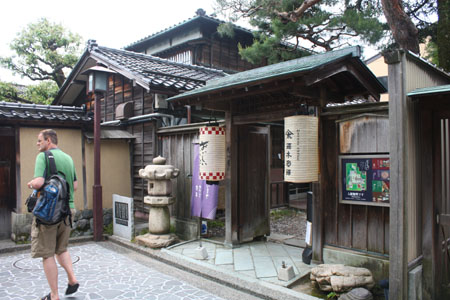 storm the castle for a hostile army. We visit a number of the houses that
were once owned by middle class samurai. Most samurai families have left
their homes after they had lost their position, mainly because of the
extremely high inheritance tax. Many have even committed suicide because
they could not cope with their loss of status. Many bodies were found in the
former castle moat. The houses are traditionally furnished. The largest
central room is arranged for receiving guests of equal or lower class.
Smaller rooms are for sleeping, living and eating. The gardens are
beautifully landscaped, with carp ponds and beautiful trees and plants.
Samurai also used edible plants for their garden design as an emergency
ration. It is now after five and we are tired. Fortunately, we are almost at
the end of the tour. We say goodbye to Kiyoe, which has given us a great
afternoon
storm the castle for a hostile army. We visit a number of the houses that
were once owned by middle class samurai. Most samurai families have left
their homes after they had lost their position, mainly because of the
extremely high inheritance tax. Many have even committed suicide because
they could not cope with their loss of status. Many bodies were found in the
former castle moat. The houses are traditionally furnished. The largest
central room is arranged for receiving guests of equal or lower class.
Smaller rooms are for sleeping, living and eating. The gardens are
beautifully landscaped, with carp ponds and beautiful trees and plants.
Samurai also used edible plants for their garden design as an emergency
ration. It is now after five and we are tired. Fortunately, we are almost at
the end of the tour. We say goodbye to Kiyoe, which has given us a great
afternoon
Weather: morning sunny and warm. In the afternoon cloudy and cooler. Very humid. 24°C/75°F.
Tuesday 28 May 2013
Kanazawa - Ogimachi: 90km (56mi) 1:46 hours (car)
Today we hit the road again with a rental car from
Times Car rental. The rental
office is near the station. First we go to the train station to change our
train reservation for tomorrow. We have seats reserved for the afternoon,
but we would rather leave in the morning.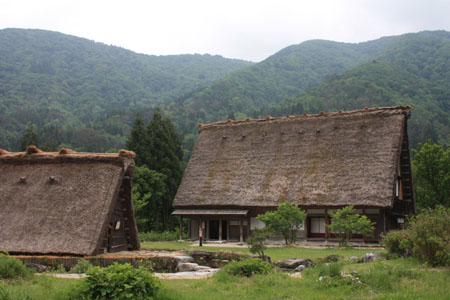 That's no problem. The clerk of Times speaks only a smattering of English,
so it's a bit difficult. We show our international driving licenses and
passports. A Dutch driving license is not valid in Japan without an
international driving license (available at the Automobile Association).
Oddly enough, those of Belgium, France, Germany and Switzerland are valid
with an authorized translation. After completion of the necessary
formalities we get a large Mazda Atenza. First we get an explanation of the
navigation system and then we drive to the regions of Gokayama and
Shirakawa-go. These are two areas where there remain a few villages with
traditional A-shaped houses with thatched roofs. It has been designated a
Unesco World Heritage site. It takes a lot of effort to maintain the houses.
The villages depopulate, because young people leave for the city. Previously
the whole village helped to replace a thatched roof within a day. That is no
longer possible and owners of these houses must now place advertisements to
invite volunteers to help from across the country
That's no problem. The clerk of Times speaks only a smattering of English,
so it's a bit difficult. We show our international driving licenses and
passports. A Dutch driving license is not valid in Japan without an
international driving license (available at the Automobile Association).
Oddly enough, those of Belgium, France, Germany and Switzerland are valid
with an authorized translation. After completion of the necessary
formalities we get a large Mazda Atenza. First we get an explanation of the
navigation system and then we drive to the regions of Gokayama and
Shirakawa-go. These are two areas where there remain a few villages with
traditional A-shaped houses with thatched roofs. It has been designated a
Unesco World Heritage site. It takes a lot of effort to maintain the houses.
The villages depopulate, because young people leave for the city. Previously
the whole village helped to replace a thatched roof within a day. That is no
longer possible and owners of these houses must now place advertisements to
invite volunteers to help from across the country
We turn off the road at Suganuma. This hamlet consists
of some 10 houses (Gassho-zukuri) with rice fields between them. We have to
pay 500 yen for the parking and an elevator takes us down from the parking
lot to the village. The cottages can be visited individually, but costs a
bit extra. Some are inhabited. After we explored the village, we drive to
Ogimachi. When we get there we first eat at a traditional
restaurant. We sit on the floor and are presented a Japanese menu, we is not
much use to us. The waiter has a handy translation app on his smartphone and
so we can order our food - despite some odd translations . It tastes great
and is not overly expensive, but more expensive than we usually had to pay
so far.
3800 yen (€ 30) for two. We can leave your car (for free) at the restaurant
and do not have to drive to the see the traditional houses here. The Gassho
Zukuri Folklore park is more like an open air museum. The houses that we see
here have been moved here from elsewhere. It therefore has much less
character. It has started drizzling and that makes it all a bit gloomy. We
still see most of the houses. The visit of the houses is included in the
ticket for the museum. You have to take off your shoes every time you enter
a house.
Next is Ainokura and that is back in the direction of Kanazawa. This is a real village, where people arel still living. The cottages are indeed not open to visitors, but they look much more authentic. The residents are busy farming their rice fields. There is only one eatery cum souvenir shop. The village is very picturesque between the mountains, some of which are covered with snow. It still drizzling, but we do not mind. After having seen the village we the expressway back to Kanazawa (toll 1400 yen).
In Kanazawa we go to the hotel, where we can park for 500 yen. We have a rest and then take the bus to the Higashi Chaya, one of the three districts where there Geishas work and train. Unfortunately, we see no Geishas walking the streets, but it's a nice district to see, with narrow streets and old houses. Kanazawa has not suffered from American bombing during the ware just like Kyoto.
Weather: 22°C/72°F, overcast and occasional drizzle.
Wednesday 29 May 2013
Kanazawa - Nagano: 252km (158mi), 3:31 pm (train)
We have a remarkable breakfast again. Erik has a western breakfast. That
means two slices of bread, a soup and a ceramic pan heated by some sort of
solid fuel in which he can fry his own egg. I have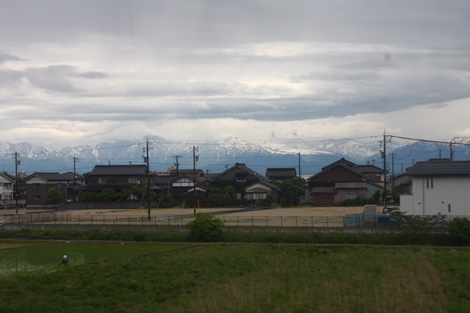 a Japanese breakfast of noodles, soup, rice, and a small fry pan over a fire
with a soup, vegetables and some tofu pieces. After breakfast we bring the
car back to Times Car Rental in the pouring rain. At the railway station we
take the limited express train Hakutaku to Naoetsu (1 hr:44 min). There we
have 11 minutes lay over before our nextslow JR train Shinetsu that brings
us to Nagano in 90 minutes. The scenery is beautiful. During the first part
we ride along the coast of the Japanese sea for quite some time. Then the
train goes inland into the mountains. Those are high and snow covered.
Unfortunately it rains for most of the trip. When we arrive In Nagano it has
become dry and we walk about 10 minutes to the hotel
Chisun Grand which is located close to the railway tracks.
It is a modern business hotel, which was built here for the Winter Olympics
of 1998. We have a spacious room for only 75 euro (without breakfast). We
rest for a while before go out exploring the city. We drink coffee at
Starbucks and see some stores. We go back to the hotel only to go out
later for a cocktail at an Italian Bar. Here, the staff does not speak
anything but Japanese, but with some difficulty, we manage to order two
cocktails. From there we go to a tiny pub, stuffed with a huge amount of
junk – they prefer the lived in look aparently - where you can eat
reasnoably well for little. India za Supaisu it is called and it is close
to the London double decker bus that seens to have been stranded on the
Chuo-dori.
a Japanese breakfast of noodles, soup, rice, and a small fry pan over a fire
with a soup, vegetables and some tofu pieces. After breakfast we bring the
car back to Times Car Rental in the pouring rain. At the railway station we
take the limited express train Hakutaku to Naoetsu (1 hr:44 min). There we
have 11 minutes lay over before our nextslow JR train Shinetsu that brings
us to Nagano in 90 minutes. The scenery is beautiful. During the first part
we ride along the coast of the Japanese sea for quite some time. Then the
train goes inland into the mountains. Those are high and snow covered.
Unfortunately it rains for most of the trip. When we arrive In Nagano it has
become dry and we walk about 10 minutes to the hotel
Chisun Grand which is located close to the railway tracks.
It is a modern business hotel, which was built here for the Winter Olympics
of 1998. We have a spacious room for only 75 euro (without breakfast). We
rest for a while before go out exploring the city. We drink coffee at
Starbucks and see some stores. We go back to the hotel only to go out
later for a cocktail at an Italian Bar. Here, the staff does not speak
anything but Japanese, but with some difficulty, we manage to order two
cocktails. From there we go to a tiny pub, stuffed with a huge amount of
junk – they prefer the lived in look aparently - where you can eat
reasnoably well for little. India za Supaisu it is called and it is close
to the London double decker bus that seens to have been stranded on the
Chuo-dori.
Weather: cloudy with some sunny spells and showers. 25°C/77°F
Thursday 30 May 2013
I get up very early, at 5:20 am for the morning ceremony in the
Zenko-ji
temple . To get to the Temple on time I take a taxi and
get there at 5:45. It is still very quiet, but with time more and
moreworshippers from all over Japan gather around the temple square.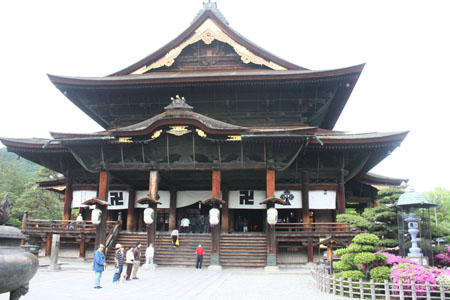 At 6 o'clock a bell is sounded, and the priest enters the front yard. He is
protected against the (absent) sun with a huge red paper umbrella. The
worshippers kneel down on his left side and he strokes there heads in
passing with a kind of rosary. A diligent police officer tells me not to
film the scene, but I have done it anyway. The priest and his entourage go
into the temple followed by everyone else. The worshippers kneel on the
tatami mats, the rest stay behind a low fence. The monks gather around the
shrine chanting their sutras. The priest climbs a few steps in front of an
altar and at one point a screen is pulled up revealing a statue. The priest
performs a number of rituals and sounds a bell. After that, the screen goes
down and the singing continues. This is repeated a couple of times in more
or less the same way. Halfway through the ceremony also the priestess makes
her entrance. At some point some of the believers are allowed to come closer
at the sacred shrine. Some of the monks have already left. There is beating
of drums, sounding of bells and many sutras are sung. After a while, the
first group of believers leave and a second groups gets a go. The whole
ritual is repeated.
Then the ceremony is finished and the priest leaves the temple
grounds with his entourage. Again believers line up along the priest’s path.
The Zenko-ji Temple is one of the last places of pilgrimage Japan. It dates
from the 7th century and Nagano was built around it. The temple dates from
before the time that Buddhism in Japan split into various sects. It
therefore welcomes followers of all sects. The temple is now run by the
Tendai and Jodusho-sects. The Tendai sect sends the high priest, the
Jodusho the high priestess. The priestess is usually a member of the
imperial family. The main Buddha image is a Hibutsu, a hidden Buddha, which
is not shown to the public, even the priest will not see it. A replica is
displayed every six years. I take a taxi back to the hotel. We have
breakfast together on the 12th floor of the hotel. It is a beautiful tatami
room, but with low tables and chairs. The breakfast is fully Japanese:
noodles, fish, meat, rice, vegetables, prunes, pikkels, lettuce, egg and
much more. After breakfast we go r to the Zenko-ji temple together. First,
we have a look at the residence of the priestess, then the residence of the
priest. There is a statue of guardian god for the aborted and stillborn
children. The fence behind it is covered in baby clothes and toys, left
there by grieving relatives. We walk on and pass a row of six Buddha
statues, representing the six states, which is a true Buddhist must endure,
i.e. hell, hunger beasts, carnage, humanity and heavenly existence. In front
of the temple is a pot adorned with an image of a lion, in which incense is
burned. Visitors wave the smoke towards themselves. It protects them
At 6 o'clock a bell is sounded, and the priest enters the front yard. He is
protected against the (absent) sun with a huge red paper umbrella. The
worshippers kneel down on his left side and he strokes there heads in
passing with a kind of rosary. A diligent police officer tells me not to
film the scene, but I have done it anyway. The priest and his entourage go
into the temple followed by everyone else. The worshippers kneel on the
tatami mats, the rest stay behind a low fence. The monks gather around the
shrine chanting their sutras. The priest climbs a few steps in front of an
altar and at one point a screen is pulled up revealing a statue. The priest
performs a number of rituals and sounds a bell. After that, the screen goes
down and the singing continues. This is repeated a couple of times in more
or less the same way. Halfway through the ceremony also the priestess makes
her entrance. At some point some of the believers are allowed to come closer
at the sacred shrine. Some of the monks have already left. There is beating
of drums, sounding of bells and many sutras are sung. After a while, the
first group of believers leave and a second groups gets a go. The whole
ritual is repeated.
Then the ceremony is finished and the priest leaves the temple
grounds with his entourage. Again believers line up along the priest’s path.
The Zenko-ji Temple is one of the last places of pilgrimage Japan. It dates
from the 7th century and Nagano was built around it. The temple dates from
before the time that Buddhism in Japan split into various sects. It
therefore welcomes followers of all sects. The temple is now run by the
Tendai and Jodusho-sects. The Tendai sect sends the high priest, the
Jodusho the high priestess. The priestess is usually a member of the
imperial family. The main Buddha image is a Hibutsu, a hidden Buddha, which
is not shown to the public, even the priest will not see it. A replica is
displayed every six years. I take a taxi back to the hotel. We have
breakfast together on the 12th floor of the hotel. It is a beautiful tatami
room, but with low tables and chairs. The breakfast is fully Japanese:
noodles, fish, meat, rice, vegetables, prunes, pikkels, lettuce, egg and
much more. After breakfast we go r to the Zenko-ji temple together. First,
we have a look at the residence of the priestess, then the residence of the
priest. There is a statue of guardian god for the aborted and stillborn
children. The fence behind it is covered in baby clothes and toys, left
there by grieving relatives. We walk on and pass a row of six Buddha
statues, representing the six states, which is a true Buddhist must endure,
i.e. hell, hunger beasts, carnage, humanity and heavenly existence. In front
of the temple is a pot adorned with an image of a lion, in which incense is
burned. Visitors wave the smoke towards themselves. It protects them
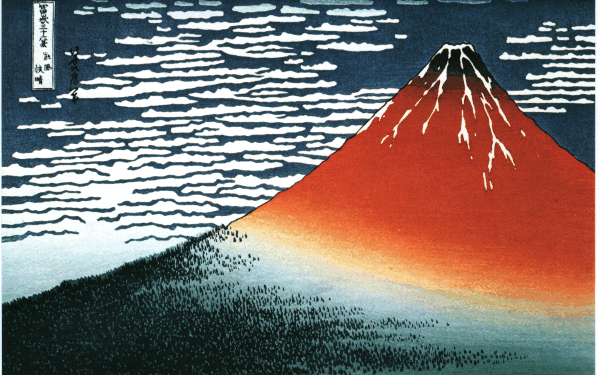 against
all kinds of illnesses and evils. We go into the temple. It is a lot quieter
now. I buy a ticket to the inner sanctum, the Okaidan. That's a pitch-black
tunnel, where you can find the way to eternity, if you find the key. It is
more likely that you will find the doorknob. You can not see a thing and by
touch I reach the exit again, without finding the key, though.
against
all kinds of illnesses and evils. We go into the temple. It is a lot quieter
now. I buy a ticket to the inner sanctum, the Okaidan. That's a pitch-black
tunnel, where you can find the way to eternity, if you find the key. It is
more likely that you will find the doorknob. You can not see a thing and by
touch I reach the exit again, without finding the key, though.
In the afternoon we take the Dentetsu line to Obuse. This is a private railway, so the JR Rail Pass is not valid. Obuse must be a very nice place, but in the rain it loses much of its charm. A number of artists have lived and worked here. Furthermore, the village has a thing with chestnuts and chestnut wood.The sidewalks are paved with it. There are also many apple orchards in the area and two Sake distilleries. We have lunch first and then go to the museum of the artist Hokusai (1760-1849), who worked here the last seven years of his life and painte beautiful pencil drawings on canvas and has decorated two floats for a local festival. The drawing of Mount Fuji, which is printed on our Rail Pass was made by him. After the museum we do some Sake tasting at a Sake Brewery. I take a dry sake, suitable as a digestif. The glass is completely full to the edge and you need to put some salt in your mouth before drinking. It tastes quite good. We take the slow train back to Nagano.
Weather: rainy, 19°C/66°F
Friday, May 31, 2013
Nagano - Yudanaka: 33km (20mi), 45 min (train)
We take the train run by the Snow Monkey Nagano Electric Railway line
(Dentetsu)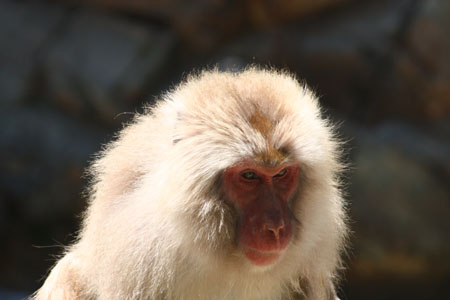 to Yudanaka. We are going to see the wild macaques who hang around Yudanaka
around a thermal spring. At the Yudanaka station we are approached by an
elderly volunteer, who gives a brochure with the bus schedules and refers us
to the counter where we can buy bus tickets. The bus drops us off at the
stop Kambayashi Onsen. From there it is a half hour walk to Monkey Park.
First a steep stretch of road, then a mildly rising path through the woods
of the Jigokudani valley. It is a pleasant walk through nature. Along the
way we see pictures of birds that live here, posted on the trees. The "park"
has an entry fee of 500 yen. A sign warns that the monkeys are not always
there. They are, after all, wild and do what they want. However, we soon see
the first monkeys. They belong to a group of wild macaques, who lives here
in the area at 850 meters altitude. They hang out mainly in and around a
thermal bath, since they were here fed once by a hotel owner in the 1960s.
There are a few dozen. In winter - a third of the year the area is covered
in snow - they are mainly in the warm thermal natural pool, which is how
they got their nickname Snow Monkeys.
to Yudanaka. We are going to see the wild macaques who hang around Yudanaka
around a thermal spring. At the Yudanaka station we are approached by an
elderly volunteer, who gives a brochure with the bus schedules and refers us
to the counter where we can buy bus tickets. The bus drops us off at the
stop Kambayashi Onsen. From there it is a half hour walk to Monkey Park.
First a steep stretch of road, then a mildly rising path through the woods
of the Jigokudani valley. It is a pleasant walk through nature. Along the
way we see pictures of birds that live here, posted on the trees. The "park"
has an entry fee of 500 yen. A sign warns that the monkeys are not always
there. They are, after all, wild and do what they want. However, we soon see
the first monkeys. They belong to a group of wild macaques, who lives here
in the area at 850 meters altitude. They hang out mainly in and around a
thermal bath, since they were here fed once by a hotel owner in the 1960s.
There are a few dozen. In winter - a third of the year the area is covered
in snow - they are mainly in the warm thermal natural pool, which is how
they got their nickname Snow Monkeys.
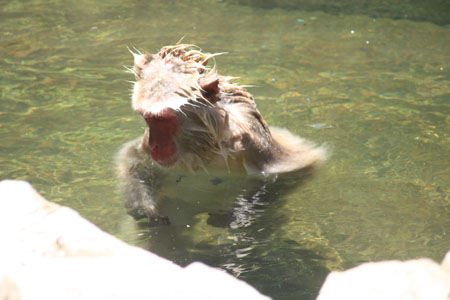 Now
they most of them sit around the pool. They play and groom each other and
are oblivious of the people. A lovely sight to watch. A few take a bath in
the warm water. After half an hour we have seen it all and walk back to the
main road. We eat in a small eatery, which specializes tempura and noodles.
Then we walk to a bath or Onsen for a dip in a thermal rotemburo. An Onsen
is a bath facility with a tub filled with hot water from a thermal source.
The natural or landscaped tun is called a rotemburo. It is very quiet, we
have the bath to ourselves. After a thorough wash and shower seated on a low
stool, we step into the warm water and take a seat in the shade of an
umbrella. Men and women are separated here too and this time the water is
very hot. Up to 50°C (122°F). We dare not move. In the distance we see some
snow-capped mountains. After the bath we take the bus back to Yudanaka and
from there the express train to Nagano.
Now
they most of them sit around the pool. They play and groom each other and
are oblivious of the people. A lovely sight to watch. A few take a bath in
the warm water. After half an hour we have seen it all and walk back to the
main road. We eat in a small eatery, which specializes tempura and noodles.
Then we walk to a bath or Onsen for a dip in a thermal rotemburo. An Onsen
is a bath facility with a tub filled with hot water from a thermal source.
The natural or landscaped tun is called a rotemburo. It is very quiet, we
have the bath to ourselves. After a thorough wash and shower seated on a low
stool, we step into the warm water and take a seat in the shade of an
umbrella. Men and women are separated here too and this time the water is
very hot. Up to 50°C (122°F). We dare not move. In the distance we see some
snow-capped mountains. After the bath we take the bus back to Yudanaka and
from there the express train to Nagano.
In the evening we eat at Saya Gaya, near the hotel. There is no English menu, but the waiter was so kind toexplain things. Erik takes beef and I have a fish, which the waiter called Plouwe or something.
Weather: Hot and sunny. In Yudanaka, in the mountains about 23°C/73°F degrees in Nagano 27°C/80°
|
|
Andere Reisverslagen |
|
| back | Photo-Album Japan | continue |